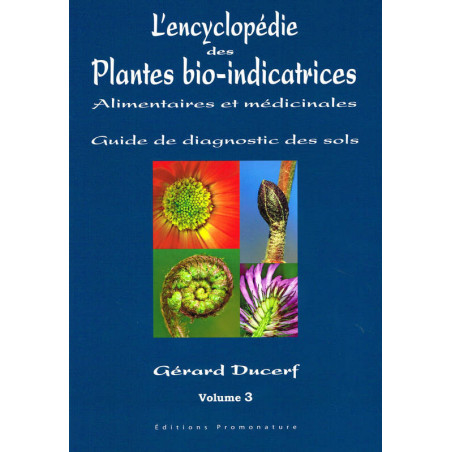Gérard Ducerf, a field botanist since 1979 and former farmer-breeder-gatherer of medicinal plants, has developed a deep understanding of the land and plants, allowing him to develop the concept of bio-indicator plants for soil diagnostics. He has organized training sessions for farmers, technicians, and any individual looking to improve their practices to sustain life in their plots and produce quality food while understanding and respecting the Nature of which we are all intimately a part. He is the author, among other works, of the book "Les plantes bioindicatrices: guide de diagnostic des sols," published in 2003, the first work presenting this innovative vision.
Volume 3 of the Encyclopedia of bio-indicator, food, and medicinal plants offers concrete case studies to better understand the relationship between plants, soil, and human interactions. Apparently contradictory, the presence of certain plant species can shed light on the need to grasp and thus better understand the role of plants as a means of information about what is happening in a specific location based on past or present human or agricultural activities. The importance of biodiversity is highlighted through long-term plot monitoring, as the risk of erosion, or even its disappearance, poses a problem for the conservation of cultivated varieties, the maintenance of bee life, etc. Common-sense solutions exist, and it is essential to apply them promptly to sustain soil life and its natural productivity for all of us to be able to feed ourselves sustainably.
Wild plants can also feed humanity: they have accompanied humans throughout their evolution, gathered when they were hunter-gatherers, and then selected and cultivated when they became sedentary. They provide vital supplements during times of scarcity. In the Capitulary of Villis issued under Charlemagne, certain herbs were cultivated to be used only during times of famine. In this volume 3, numerous original photos help identify over 270 new plants. The fact sheets specify the bio-indicator characteristics for conducting a soil diagnosis based on the species present in a field. A new logo further refines the understanding of plants from different agronomy and ecology perspectives. The medicinal and food properties of the species are presented, along with a recipe book and a guide to useful plants during times of scarcity, allowing for the discovery of the subtleties of these natural treasures.





